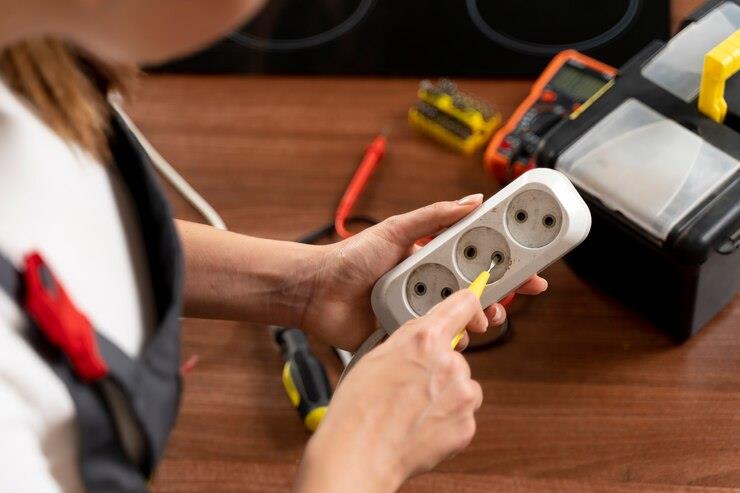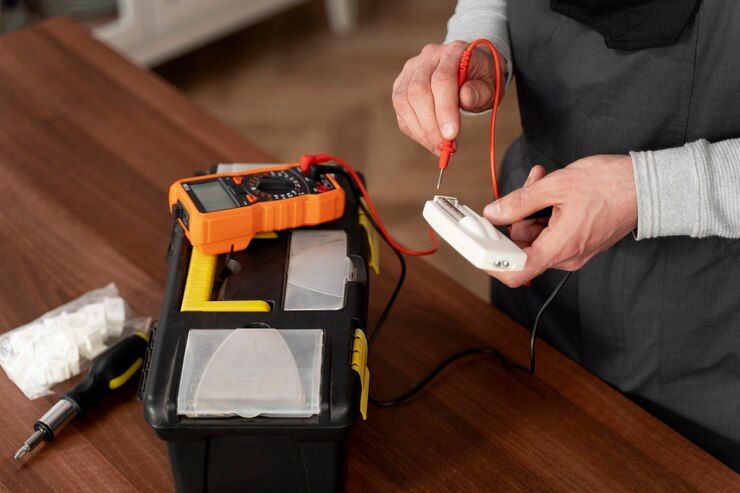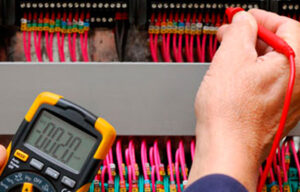Have you ever noticed the little bright stickers placed on your workplace or local electrical appliances? These tags are not decorations; they facilitate a vital safety process called Test and Tag.
Before you brush it off as just another technicality, let me assure you it’s more interesting and vital than you might think! When discussing test and tag requirements, one thing comes to mind—ensuring that electrical gadgets are safe to use, thus reducing accident risks and keeping everyone, including you, safe.
Therefore, let us delve into Test and Tag, where security matches ease of mind. Let’s find out why these tiny tags or labels mean so much. Understanding this procedure can save lives, whether a person is a business owner, landlord, or even an interested individual.
Are we ready? Let’s do this!

Understanding Test and Tag
It sounds simple enough to say Test and Tag, but the truth is that there is more to it than meets the eye. Test and Tag is about confirming that your electrical appliances function properly and operate safely. It acts as a proactive measure to prevent the escalation of minor issues into significant dangers.
So, how does one describe it in actual terms? The word “Test” involves analysing electric machines in search of flaws that might result in safety hazards such as electric shocks or fire outbreaks.
This is not just a quick look; it’s an elaborate assessment using specialised equipment like insulation resistance testers and earth continuity testers. Think of it like high-tech detective work examining every wire and plug.
After meeting the electrical testing stage, “Tagging” comes. This step shows that the item has undergone inspection successfully and been proven safe for use by being tagged with a visible seal of approval, using which people can be made aware if a device has been tried out, passed, or deemed stable for operation.
The tag isn’t simply a sign of conformity; rather, it is an emblem of certainty. Usually, including details such as the date tested, next due date, and technician contact information makes maintaining these schedules easy.
You may be curious about the reason for this uproar. It is because we must never take safety concerns casually. Whether you are an entrepreneur who wants to keep your workers safe or just someone trying to guarantee the security of your family at home, you need to understand and implement test and tag.
The test and tag Sydney is a simple but effective method to eliminate risks, comply with Australia’s safety rules, and ensure a secure environment.
Consequently, whenever you see a tagged device or plug, know there is much more to it than meets the eye – besides being labelled appropriately, it promises electrical compliance and peace of mind.

The Test and Tag Process: A Step-by-Step Guide to Safety
Test and Tag procedure is a simple yet essential way to guarantee electrical safety in any setting. Let’s take a look at the procedure.
Visual Inspection
Before leaving on their voyage, an expert technician carefully examines equipment for signs of wear or damage, indicating it should be replaced or serviced immediately.
It’s similar to thoroughly inspecting your appliances to identify any visible problems, such as frayed cables, exposed wires, or damaged plugs.
This first inspection is essential since, if neglected, even little damage can develop into major issues.
Electrical Testing
Next up comes the very heart of the matter. The technician performs several tests on the device using special equipment to measure its electrical safety. This device is called PAT tester or portable appliance tester. The tests include – taking levels of insulation resistance, earth continuity, and polarity. This is like making your device undergo an arduous fitness test to ensure it can handle the current flowing safely without any shock or fire risks.
Labelling
A tag is what this, after all, comes down to when the appliance successfully passes all these necessary examinations. It goes beyond just being a sticker; it serves as an official mark because a given appliance has been inspected and found safe for use.
Generally, the tag will have details such as the testing date, the next scheduled date for testing, and tagging that identifies who did it, which gives a good reminder to keep your devices updated regarding safety checks.
Documentation
Finally, meticulous record-keeping is carried out at this stage. For each test done, results are recorded, showing their history regarding safety as far as equipment is concerned. In compliance with security regulations and maintenance history tracking for every gadget, this document is vital for every company’s well-being.
Types of Equipment Requiring Test and Tag
Electrical safety is more than just ticking a box; it’s about recognising the specific requirements of each piece of equipment and ensuring they are safe for their intended use. Let’s discuss what types of equipment require regular test and tag processes and why they are important.
High-Risk Equipment
Think about tools and machinery used on construction sites or industrial areas. These locations have high risks due to the nature of work and the harsh environmental conditions workers face. This class includes power tools, heavy-duty extension cords, and portable RCDs (Residual Current Devices).
Often, these items are roughly handled or exposed to severe climatic conditions, making them prone to damage. They should be tested at least once every three months to ensure their reliability without compromising safety.
Office Equipment
The office may seem low-risk, but be aware. Common gadgets such as computers, printers, and kitchen appliances also need checking up occasionally. While the risk might not be as high as in industrial environments, defective office machinery can still cause electric shocks or fires to break out. Usually, annual testing takes place according to yearly schedules.
Specialised Devices
Some gears require keen attention because of their usage or environment. For example, medical devices or equipment in the laboratory must be functional, as their malfunction may have fatal consequences. The testing frequency for this equipment will depend on what the equipment does and the risks that can come from a failure.
Infrequently Used Equipment
Even devices not frequently used often need to be on the hook. Things like backup power generators, which are only used during natural disasters, should undergo a complete test when necessary so they would work properly when required. Office equipment is allowed to be tested and tagged for a period of five years.
Benefits of Regular Tests and Tag
Enhanced Safety
The main advantage of regular PAT Testing (Portable Appliance Testing) is improved safety. Electrical faults may happen anywhere, from busy workplaces to quiet residential homes, exposing people to severe effects like electric shocks, fires, or even explosions.
Regular inspections and tests help identify and address potential hazards before they become dangerous. This way, not only those who use the equipment but also people around are safe.
For example, frequent testing should be conducted in high-risk environments like construction sites with rampant power tools and heavy machinery. Such tough conditions can quickly wear out equipment, thus increasing the chances of electrical faults. Consistent checks can ensure that these devices operate as expected, thereby minimising accident risks.
Legal Compliance and Liability Reduction
By law, Australian companies have to maintain secure work areas. Depending on the risk level of the setting, the Australian Standard AS/NZS 3760 requires that electrical appliances undergo regular Test and Tag procedures. Failure to follow these laws attracts massive penalties apart from legal consequences and increased liability if an accident occurs.
Standard test and tag procedures are essential for businesses to meet legal requirements and provide documented evidence of compliance. A well-kept log of all test and tag activities is important. It can reduce liability if an accident occurs since it indicates that due diligence has been given to safety and regulatory compliance.
Cost Savings
Frequent test and tag initiatives may appear costly but cheaper in the long run. By promptly fixing insignificant cases, they will never become serious ones requiring expensive repairs or complete equipment replacements.
For instance, during a routine inspection, the un-insulated wire could be identified and rectified instead of waiting until a severe malfunction damaged the machine and caused a fire outbreak.
Also, functioning monitoring of such devices can help prolong their working life immensely. High-quality maintained tools have the least chance of surprising breakdowns, reducing the need to be replaced frequently and equipment costs.
Enhanced Productivity and Efficiency
Unexpected equipment downtime caused by electrical failures can interrupt operations and reduce productivity. For businesses, this implies that they miss out on money in the form of revenue and deadlines not met. Regular Test and Tag reduces such disruptions by ensuring all machines are reliable and working at their best. When employees have confidence in the operational worthiness of their tools and devices, they work without worry or anxiety about possible breakdowns.
Furthermore, regular maintenance through Tests and tagging can increase the efficiency of electrical equipment. As an illustration, electric systems running with maximum performance require less energy, reducing energy costs. This is particularly useful in environments with many electronic devices, such as data centres or offices.
Peace of Mind and Reputation Management
Business owners and employees enjoy peace knowing that their electrical equipment meets safety requirements. It ensures a feeling of security at the workplace where everyone concentrates on his/her work without fearing electrocution risks. In addition, this kind of work environment encourages workers’ spirit while reducing their stress levels.
Insurance Benefits
Many insurance policies require proof of regular maintenance and safety checks, including Tests and Tags, to cover claims related to electrical incidents. Organisations must adhere to this requirement to meet the conditions of their insurance policy.
If these requirements are met, it will help protect businesses from financial losses if anything happens. In addition, this can lead to reduced premiums since they show a decreased probability of electrical accidents happening.
Ultimately, though, the advantages of regular Tests and Tags are more than just about compliance. They include safety, legal protection, cost savings, productivity, peace of mind, and possible insurance benefits.
Incorporating this habit into routine maintenance schedules facilitates a safer, more efficient, and reliable environment for homeowners and businesses. Don’t wait for an accident to happen before considering electrical safety because make testing and tagging part of your everyday safety protocols.

How to Implement a Successful Test and Tag Program
Assess the environment and your equipment.
The first stage in establishing a testing and tagging campaign is to inspect and identify all electrical equipment requiring testing. This may range from high-risk equipment in industrial settings to everyday office appliances.
Make an extensive inventory of all devices with notes on their location, how frequently they are used, and their condition.
Through this initial audit, we will understand the program’s scope and determine how often tests should be conducted for each device based on industry standards and the associated risks.
Develop a Testing Schedule
The next step involves creating a testing schedule upon obtaining a comprehensive list of materials involved. An appropriate frequency of testing must be developed depending on the risk level of equipment and its application context; for example:
- High-risk environments (e.g., construction sites)-every three months.
- Medium-risk environments (e.g., factories)- every six months.
- Low-risk environments (e.g., portable items )- annually.
- Infrequently used equipment: Every five years or when needed.
This timetable must be logged so everyone can observe it, thus ensuring compliance and creating the possibility of questioning.
Hire Qualified Professional
Hiring trained and authorised experts who will carry out the testing and tagging process is important. Qualified technicians in Australia should be able to perform electrical safety tests aligned with AS/NZS 3760.
Specialists like these are equipped with tools to conduct visual inspections, insulation resistance measurements, and earth continuity tests. Their expertise ensures that testing is done thoroughly and accurately, reducing the chances of undiscovered faults.
Develop a Record Keeping System
A successful Test and Tag program depends on accurate record-keeping. There should be records attached to all tested equipment showing:
- The date of testing
- Results obtained from the test
- Next scheduled test
- Details of technician involved
These records must be easily accessible and examined, especially during safety audits or inspections. Digitalised methods can store this information to facilitate this process, enabling constant amendments and providing data retrieval when needed.
Documentation and Tagging
Upon completion of the tests, each piece of equipment should be labelled to show it has been tested and is safe for usage. The tag must incorporate necessary details such as the test date, the next test due date, and the tester’s name or certification number. This serves as a visible verification that convinces users about the safety of such equipment and helps ensure adherence to safety laws.
Training and Awareness
For this program to be successful, your team needs to understand its importance, e. Training sessions should be organised to enlighten employees on how these tags are used so that they can learn about procedures involved in tagging and reporting suspicions of damaged equipment. It provides an all-around safety culture by encouraging cooperation and creating a safer environment.
Regular Review and Updates
A successful Test and Tag program is not static; it requires regular review and updates. Periodically assess the program’s effectiveness, adjust the testing frequency as needed, and incorporate any new equipment into the schedule. Stay updated with changes in safety rules and standards to ensure ongoing compliance.
Use Technology
Using technology to increase the productivity and precision of your Test and Tag program. Software can be employed for this purpose, such as those that can be utilised in the scheduling process, recording of results, and report making. It is possible to find some high-end systems with test reminders that integrate with other safety management systems, taking a total approach towards workplace safety.

Lasy Say!
We must always test and tag all electronic equipment to ascertain their safety and conformity to the law. Furthermore, it keeps staff and customers safe from electrical hazards while at the same time protecting the integrity of your business operations. It also helps minimise risks by proactively improving workplace safety, reducing the chances of expensive penalties and liabilities.
Whether managing a small office or a large industrial facility, integrating regular Sydney test and tag practices into your maintenance routine is crucial for creating a safe environment and providing peace of mind. Ultimately, it’s about more than just adhering to regulations; it’s about prioritising the health and safety of everyone who uses your equipment.





